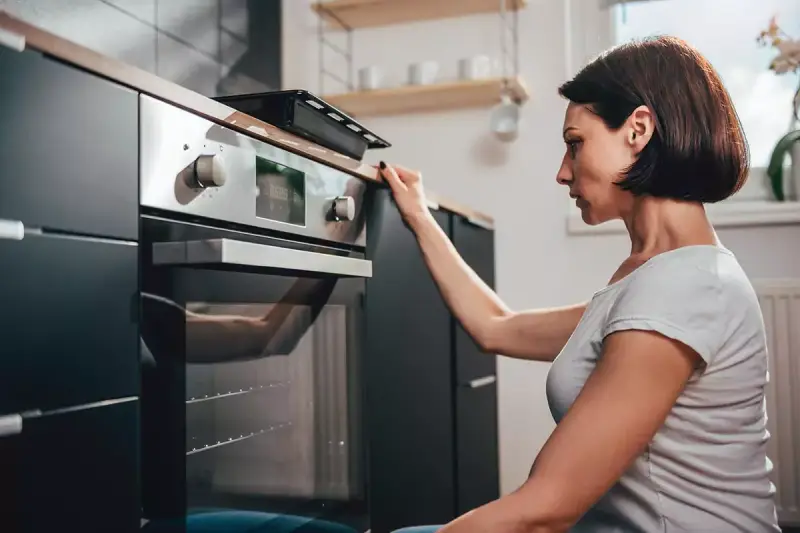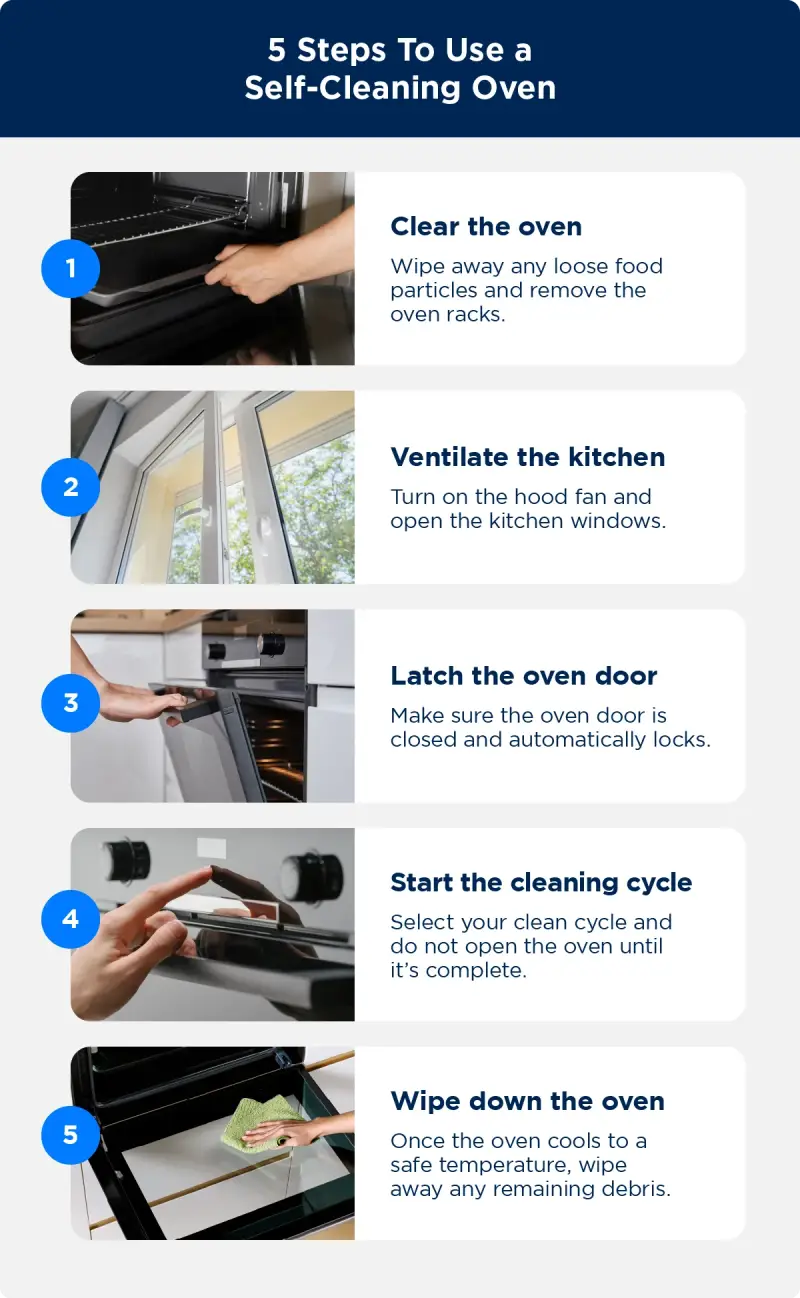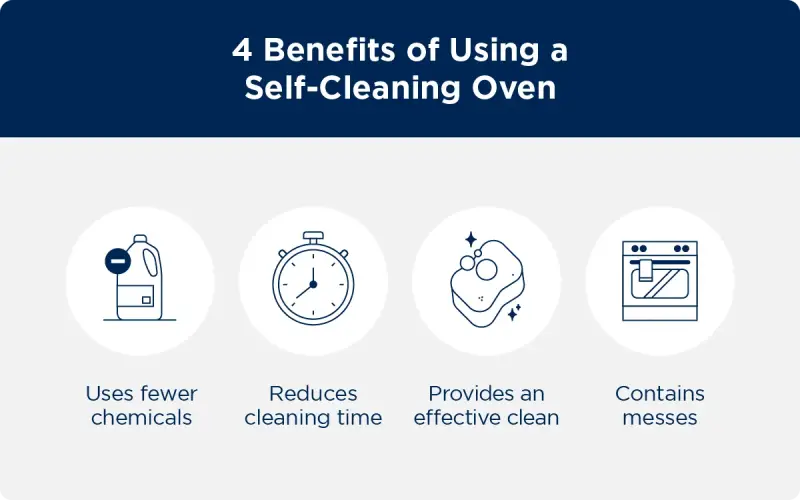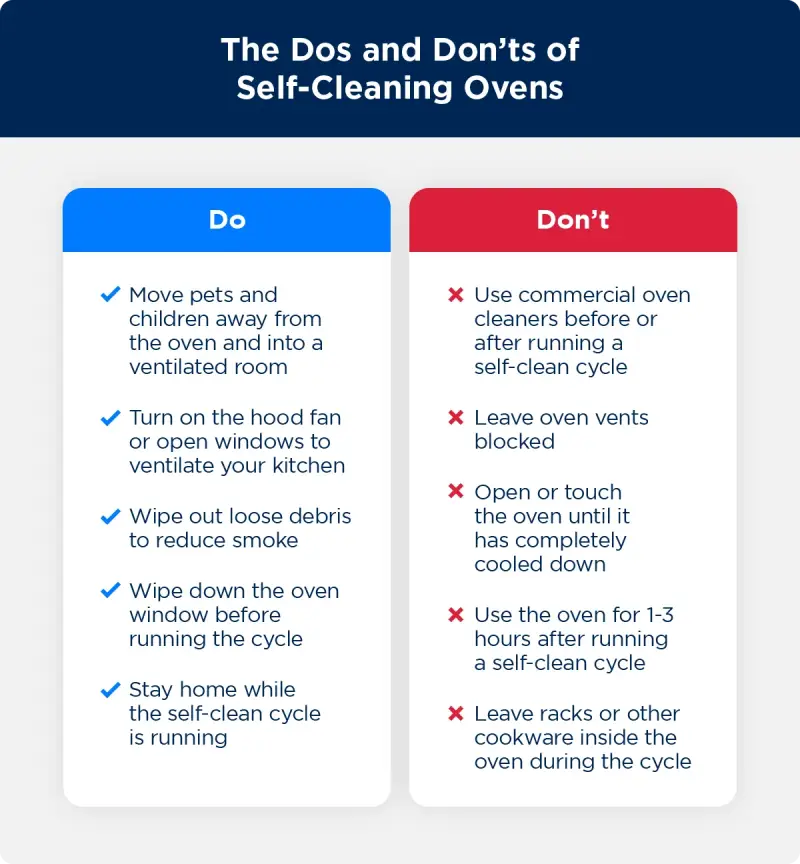Self-Cleaning Ovens: Essential Tips and Tricks for Safe Use

Cleaning an oven is often a dreaded chore, as it can take hours to scrub away old food residue and oil that’s stuck to the inside. However, self-cleaning ovens help maintain cleanliness, so you no longer have to scrub away buildup for hours on end. In this guide, our experts explain what a self-cleaning oven is, how it works, and how to use this feature safely.
How Does a Self-Cleaning Oven Work?
Self-cleaning ovens work by heating to extremely high temperatures — between 800 and 900 degrees Fahrenheit — to break down oil, grime, and food residue. The high temperature turns the residue into ash, making it easy to wipe clean.
How Long Does a Self-Cleaning Oven Take?
A self-clean cycle can take anywhere from two to six hours, including the heating and cooling process, but the cycle length can vary depending on the model you have and the amount of buildup in your oven. Some models automatically run for a set amount of time, while some allow you to choose the length of the cleaning cycle.
How To Use a Self-Cleaning Oven

Ready to utilize your self-cleaning oven to help get rid of food remnants and buildup? Here are the steps to safely use your oven’s self-clean feature.
Tip: Always check your owner’s manual for specific instructions when using the self-cleaning oven setting, as it may differ between brands and models.
1. Clear the Oven
Start by removing the oven racks and anything inside and around the oven, like pots on the stovetop or tea towels hanging from the oven handle.
Then, do a thorough wipe-down with a damp cloth to remove any loose food particles or puddles of grease. When heated to high temperatures, leftover debris can cause excess smoke and catch fire during the cleaning cycle.
You’ll also want to make sure to wipe down the oven door, including the glass window and frame. This can prevent stains on the window and ensure there are no food particles left over that could stop the door from sealing properly.
2. Ventilate the Kitchen
Ventilation is extremely important when running a self-clean cycle on an oven. Turn on the hood fan to help reduce smoke and odor, and make sure to open up the windows. For extra air circulation, turn on any ceiling fans in your kitchen.
3. Latch the Oven Door
Next, make sure you close the oven door and lock it completely. Your oven might automatically lock when selecting the self-clean feature — most self-cleaning ovens won’t allow the cycle to begin if the door isn’t locked properly. If you’re having issues with your oven door when trying to run a self-clean cycle, there may be an issue with the hinge.
4. Start the Cleaning Process
Some ovens allow you to choose a self-clean setting, including light, moderate, or heavy, depending on the amount of buildup you have in your oven. The different settings will run for different periods of time but will typically run anywhere from two to six hours.
During the cleaning process, the oven will get extremely hot, so make sure not to touch or open the oven door until the cycle is complete. You may also want to consider moving to another room while the oven is self-cleaning, as it may exude unpleasant odors.
5. Wipe Down the Appliance
Your oven should automatically unlock once the cycle is complete and the oven has dropped to a safe temperature. Once cooled, use a damp cloth to wipe away the ash and remaining residue inside the oven, giving the outside of the oven a good wipe-down as well. Once everything is clean, you can replace the oven racks.
Benefits of a Self-Cleaning Oven

The self-clean feature is convenient and makes it easy to keep your oven in tip-top shape. Here are some benefits of using a self-cleaning oven:
- Fewer chemicals: Traditional oven cleaners contain harsh chemicals that linger and can be toxic to you and your family. The self-clean feature offers a safer (and often more effective) alternative to chemical cleaners.
- Saves time: The self-clean feature cuts down on manual cleaning time and makes it easy to simply wipe away old debris and buildup that otherwise would have taken hours to clean by hand.
- Effective clean: Aside from saving time, self-cleaning ovens clean more effectively by taking care of hard-to-reach areas you may have otherwise missed when cleaning by hand.
- Contains messes: Manually cleaning your oven can make a huge mess, but with the self-clean feature, the mess is contained in the oven and easier to clean once the buildup has burned off.
How Often Should You Use the Self-Clean Oven Function?
It’s recommended to run a self-clean oven cycle every four to six months, but you can go longer if you don’t use your oven frequently. For example, if you bake often, you may want to consider using the self-clean feature every four months, but if you only bake on occasion, you’ll probably benefit from running a cycle every six months.
However, you can likely go longer periods with regular oven maintenance. After you use your oven, wait for it to cool to a safe temperature, then wipe down any oils and leftover food droppings so they don’t have time to harden onto the inside of the oven.
Steam-Clean vs. Self-Clean Oven
Your oven may also have a steam-clean feature, which uses steam to remove residue and clean the oven. This feature is meant for smaller spills and messes. Using water to create steam helps soften the buildup and makes it easier to clean.
These cycles are typically much faster than the traditional self-clean feature and can take about an hour to complete. This is a great feature to use between self-clean cycles, as it’s meant for smaller cleanups.
Self-Cleaning Oven Do’s and Don’ts

The self-clean feature is convenient, but it does come with risks if not used properly. Check out the do’s and don’ts of self-cleaning ovens below to ensure you’re safely using this feature.
Self-Cleaning Oven Do’s
Remember to do the following before you run a self-clean cycle on your oven:
- Always move pets and children to a closed, ventilated room away from the oven to avoid exposure to smoke and fumes.
- Make sure your kitchen is properly ventilated by turning on the hood fan and opening the windows.
- Reduce smoke by wiping out loose debris.
- Wipe down the oven window before running the cycle.
- Stay home while the self-clean cycle is running.
Self-Cleaning Oven Don’ts
Here are a few things you should avoid when using the self-clean feature:
- Use commercial oven cleaners before or after using the self-cleaning feature.
- Leave oven vents blocked.
- Open or touch the oven until it has completely cooled down.
- Use the oven for one to three hours after the cycle is complete.
- Leave racks and items inside the oven during the cycle.
H2: Self-Cleaning Oven Dangers
Self-cleaning ovens can pose safety hazards and damage the integrity of your oven when not used correctly. Here are some potential dangers to consider when using your self-cleaning oven:
- Overworked appliance: Heating an oven to extreme temperatures requires a lot of power, which can overwork the oven. This can shorten the oven’s lifespan and may lead to costly damage.
- Fire potential: Because the oven reaches scorching temperatures during a self-clean cycle, it creates a potential fire risk if you don’t remove food debris and grease before running the cycle. If your oven catches fire, do not open the oven door, as the outside air can make the fire worse.
- Harmful fumes: Not only can the incinerated food and grime cause a very unpleasant smell in your oven, but the burnt-up debris can release small amounts of carbon monoxide into your home, which is extremely harmful. This is why it’s important to keep your windows open and have a working carbon monoxide detector installed.
Self-Cleaning Oven FAQ
Still have questions? Our experts have answers to some common questions about self-cleaning ovens and how they work.
Can You Leave the House While Oven Is Self-Cleaning?
No, you should never leave your house if your oven is on — whether you’re running the self-cleaning cycle or not. It’s always recommended to be home while using a self-cleaning oven to ensure it’s working properly, a fire doesn’t start, and other family members are keeping their distance while the oven is self-cleaning.
Is It Safe To Use the Self-Cleaning Oven?
Self-cleaning ovens are generally safe to use as long as you’re using them correctly. Keep these safety tips in mind before running the self-clean feature on your oven:
- Clean up all loose food particles and debris.
- Remove oven racks and any other cooking items.
- Don’t use chemical oven cleaners before or after the cycle.
- Ventilate your kitchen by opening windows and turning on your hood fan.
- Wipe down the oven window.
- Keep children and pets away from the kitchen.
How Does the Self-Clean Work on an Oven?
Self-cleaning ovens use extremely high temperatures to heat oil, grease, and grime that’s stuck inside the oven and turn it into ash. The process can take anywhere from two to six hours, and once the cycle is done, you can wipe the ash away with a damp cloth.
Can I Leave the Racks in the Oven While I Self-Clean?
No, you should never leave the racks in your oven while running a self-clean cycle, as the high heat can cause warping and irreversible damage. Always remove the racks and broiler pan, as well as other cooking materials, like utensils, dishes, or baking sheets.
Can You Manually Clean a Self-Cleaning Oven?
Yes. You can manually clean a self-cleaning oven; in fact, it’s encouraged to do so. Regularly cleaning your oven after each use can remove loose food particles and grease spills, which can help make the self-clean feature more effective when you’re ready to use it. The self-clean feature is meant to make cleaning hard-to-reach areas and pesky buildup in your oven easier, not for regular cleaning maintenance.
Maintain Your Oven With Mr. Appliance
Self-cleaning ovens are a great way to remove excess buildup that’s hard to reach with a manual clean. If you have trouble with your self-cleaning oven and need oven repair services, your local Mr. Appliance can help. Whether your oven door won’t close or your oven’s self-cleaning feature isn’t working, our experienced team can get to the bottom of it and help repair or replace any necessary parts.
Contact us today so we can help you with your oven repair needs.
This article is intended for general guidance only and may not be applicable to every situation. You are responsible for determining the proper course of action for your property and your situation. Mr. Appliance is not responsible for any damages that occur as a result of any advice or guidance derived from blog content. For the most accurate guidance, contact an independently owned and operated Mr. Appliance business for a professional custom and on-site assessment.
 Click to call
Click to call


